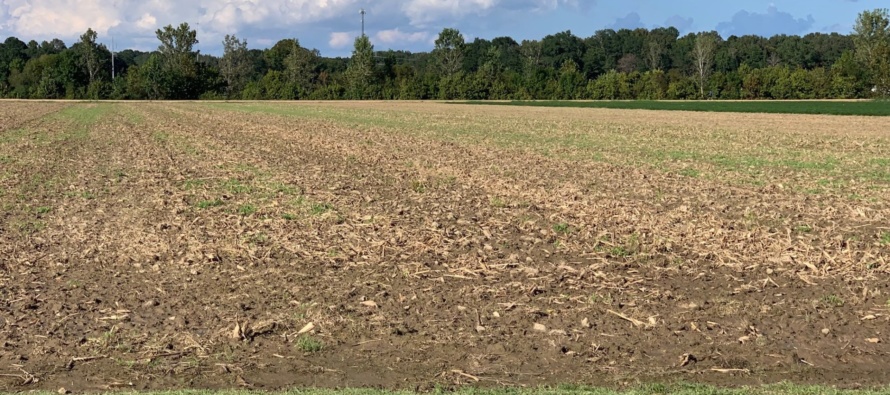Calcium and Magnesium Management for Plant Growth

Related Articles
- Fertilizing Cotton with Poultry Litter 5
- Spring Nitrogen Fertility Suggestions for Wheat 0
- Micronutrients for Mississippi Crop Production 4
Latest Tweets
Calcium (Ca) and magnesium (Mg) are essential ‘secondary’ plant nutrients. Plants need less Ca or Mg than nitrogen, phosphorus, or potassium, but require more of them than micronutrients. Should Ca and Mg be in the fall soil nutrient management portfolio?
Neither Ca nor Mg are plant nutrition issues where pH and organic matter contents are adequate in Mississippi soils. While Ca and/or Mg liming materials increase pH when soil-applied, not all Ca or Mg materials are liming agents. More accurately, these products are termed soil amendments.
Calcium in Plants and Soils
Calcium supports plant cell walls and serves as an internal biochemical messenger for plants under physical or biochemical stress. Deficiencies are rare in Mississippi soils. However, potential issues can exist in legumes grown on very low pH soils with less than 500 pounds of soil test Ca. Tomatoes and peppers in these low Ca soils will need additional calcium to prevent blossom end rot.
Calcite (calcium carbonate) rock, dolomite (calcium and magnesium carbonates), or marl (largely calcium carbonates) limes are the primary Ca sources for soil additions in Mississippi. Other sources include basic slag, gypsum, hydrated lime, and burned lime.
Gypsum – calcium sulfate – does not affect soil pH, and is used to improve soil stability in salt-impacted soils. The Ca component replaces sodium (Na+) ions on the soil exchange complex; Na thus displaced is leached (moved down the soil profile out of the rooting zone) with rainfall or irrigation.
Magnesium in Plants and Soils
Plants absorb Mg as the Mg2+ ion. It is mobile in plants and moves from older to younger leaves. In soils it potentially can be leached from soils similar to Ca and potassium with rain or irrigation.
Magnesium is involved in plant photosynthesis as the central atom surrounded by four nitrogen atoms in the chlorophyll molecule. It activates many of the plant growth enzymes, and stabilizes the nucleic acids.
Sandy soils in the Coastal Plain regions and the heavy dark clays of the Blackbelt Prairie experience some Mg issues. Occasionally, fertilizer management in some sandier soils in other areas of the state has presented challenges.
Interveinal chlorosis is a deficiency symptom in legumes, corn, sorghum, cotton, and certain leafy vegetables. The leaves may become pink to light red and may curl upward along the margins.
Dolomitic lime can address magnesium deficiency in soil when lime is required. Soluble sources of magnesium should be used when lime is not needed. The soluble sources of magnesium fertilizers include magnesium sulfate (containing 10% Mg and 14% S, also known as Epsom salt), sulphate of potash magnesia (containing 11.2% Mg, 22% S, and 22% K2O, commercially sold as K-Mag), and magnesium oxide (containing 55% Mg, also known as magnesia.
Calcium and Magnesium Ratios
Some consultants and private laboratories recommend attaining “ideal” ratios of Ca to Mg to optimize crop yields. Recent university research questions this applicability because maximum yields have been achieved across a wide spectrum of Ca to Mg ratios. For detailed information, including further citations, see:
- Chaganti, V. N. and S. W. Culman (2017). “Historical Perspective of Soil Balancing Theory and Identifying Knowledge Gaps: A Review.” Crop, Forage & Turfgrass Management 3(1): cftm2016.2010.0072 http://dx.doi.org/10.2134/cftm2016.10.0072.
- Kopittke, P. M. and N. W. Menzies (2007). “A Review of the Use of the Basic Cation Saturation Ratio and the “Ideal” Soil.” Soil Science Society of America Journal 71(2): 259-265 http://dx.doi.org/10.2136/sssaj2006.0186.
- Stevens, G., T. Gladbach, P. Motavalli and D. Dunn (2005). “Soil Calcium: Magnesium Ratios and Lime Recommendations for Cotton.” Journal of Cotton Science 9: 65-71. https://www.cotton.org/journal/2005-09/2/65.cfm.
Ca and Mg Effects on Soil Physical Characteristics
Calcium and Mg influence soil aggregation and soil structure, thus affecting soil health. The Ca2+ ion is smaller than Mg2+ hence it is more efficient in binding soil particles, and has more flocculating power (the ability to facilitate the formation of small masses) than Mg. Conversely, Mg could lower soil structural stability. As mentioned above, Ca as gypsum is used to amend soils with structural problems due to Na.
Grass Tetany
Grass tetany is a serious issue for cattle grazing annual ryegrass, small grains, or cool-season perennial grasses grown on low Ca or Mg soils. See Mississippi State University Extension Publication 2484 Mineral and Vitamin Nutrition for Beef Cattle for detailed discussion and management options concerning this important soil-fertility related subject.
Dr. Keri Jones is contributing author.





Let me tell You a sad story ! There are no comments yet, but You can be first one to comment this article.
Write a comment